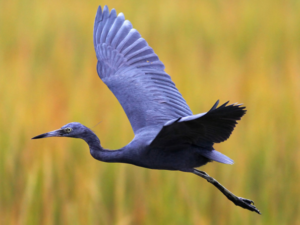
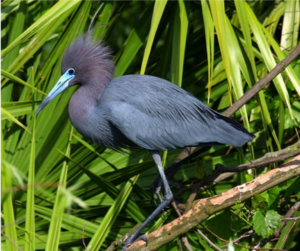
- Appearance:blue-violet head and neck, long S-shaped neck, black-tipped gray beak, blue-grey body, pale yellow legs, yellow eyes
- Males are larger than females, otherwise no differences between them
- During breeding season, both sexes develop breeding feathers on neck and back that can be raised into crests, beak changes from grey to blue, legs become dark
- Despite its name, little blue herons are a type of egret
- Height: about 24 inches (2 feet)
- Wingspan: 39-41 inches (about 3.5 feet)
- Status:common, but declining
- Dull plumage spared little blue herons from overhunting during feather trade in late 1800s, when they were used to make bright, colorful hats
- 55% decline between 1966 and 2015 – mostly attributed to habitat, also caused by pollution in waterways contaminating prey and diverting waterways
- Habitat
- Wetlands such as: swamps, marshes, ponds, streams, lagoons, tidal flats, canals, ditches, fish hatcheries, and flooded fields
- Found along east coast of United States, Mexico, Central America, and Atlantic Oceanic Islands (ex. Cuba, Caribbean)
- More than 100 million acres of wetlands in the U.S. have been drained since colonial times (when total wetland area was estimated at 127 million acres)
- Diet
- Mostly eat small fish, but also eat aquatic invertebrates, amphibians, and insects
- Forage in shallow water – wade in up to their bellies
- Forage with other shorebirds, but often defend their feeding space from other little blue herons
- Stand still or walk slowly to look for prey in water, once spotted, strike prey with sharp, pointed beak
- Migration
- Visit Long Island during summer months to breed
- On east coast, breed as far north as Maine, also extend inland along rivers such as Mississippi, rarely found in California and middle states
- Migratory populations overwinter in Central America
- Little blue herons migrate alone, with colonies disbursing in many different directions during departure
- Populations along Gulf Coast and on Atlantic islands are year-round residents, only travel locally
- Average flight speed is about 20 mph, top speed is about 30 mph, often fly into strong winds that help them fly faster
- Nesting
- Nest in shrubs and small trees in standing water or on islands, including artificial islands created from dredged material – normally isolated from predators by water
- Often form colonies with other shorebirds – “rookieries” – that can consist of hundreds or even thousands of breeding pairs
- Sometimes this devastates local vegetation and degrades the environment
- As humans drain marshlands, birds are often forced to relocate to another marshland where another colony already exists, and they may overcrowd
- After pairing, males and females both build nest – males bring material, female weaves nest out of sticks, twigs, leaves, and other vegetation male provides her
- Average brood is 3-5 pale blue-green eggs
- If humans disturb nesting sites, little blue herons will abandon nest and chicks die
- “Young of the Year”
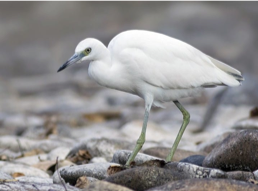
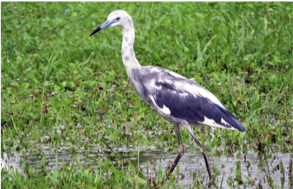
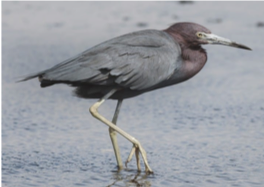
- First set of flight feathers is white except for dusky blue-gray on very tips of wings, forage around snowy egrets and other white egrets/herons to camouflage themselves from predators
- Feathers gradually change from white to blue as young mature – referred to as “Calico,” “Pied,” or “Piebald” – this takes several years
- Average lifespan is 7-10 years, oldest little blue heron was 14 years old






